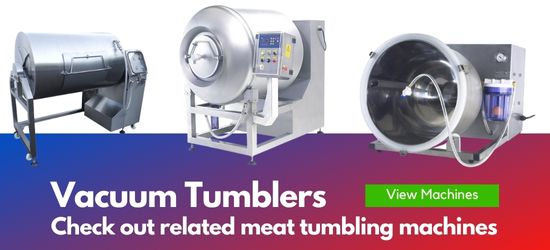Vacuum tumblers and meat marinator machines have become essential in modern meat processing. A commercial vacuum tumbler machine uses specialized technology to marinate meat in a way that maximizes saturation of spices, seasonings, and brine into the product. This process can be performed at home with small units or on a commercial scale using large meat tumbler machines that handle thousands of pounds at once.
From small tabletop vacuum tumbler marinators used in test kitchens to large-scale vacuum tumblers for meat processing, these machines help processors deliver better results while meeting consumer demand for flavor, tenderness, and consistency.
Meat processors prefer using vacuum meat tumblers because the finished products weigh more than untreated meat, with the added weight being moisture that stays locked in even after cooking. This results in juicier and tastier products. On the other hand, consumers enjoy the flavorful results without needing to spend extra time marinating meat at home.
How Does a Meat Vacuum Tumbler Work?
In the meat industry, different products are referred to as proteins. When protein is placed under a vacuum, the pores expand, allowing the marinade to penetrate deeper and faster than traditional soaking. A vacuum tumbler machine uses a rotating drum that contains both the protein and the marinade.
Once sealed, a vacuum is applied. Depending on the type of meat vacuum tumbler, tumbling may start immediately or after the vacuum reaches the desired level. Inside the drum, fins lift and drop the product repeatedly. This not only ensures deep marination but also tenderizes the meat by breaking down muscle fibers.
Types of Vacuum Tumbler Machines
There are two main types of vacuum tumbler machines used in the industry:
- Non-Continuous Vacuum Tumbler
- The vacuum is created externally and then disconnected once the desired level is achieved.
- Simple design and lower cost.
- Common in the USA.
- Continuous Vacuum Tumbler
- Uses a snorkel inside the drum to maintain constant vacuum.
- Allows advanced features such as pressure release, resting cycles, and re-introduction of vacuum.
- Creates a sponge effect for higher marinade saturation.
- Popular in Europe for industrial applications.
While continuous systems are more advanced, many processors still prefer the non-continuous vacuum tumbler marinator models due to cost-effectiveness and easy operation.
Benefits of Vacuum Tumblers for Meat Processing
Using a meat vacuum tumbler machine provides multiple benefits for processors and consumers alike:
- Increased weight of uncooked product
- Juicier, moister product after cooking
- Enhanced flavor and taste
- More tender meat due to tumbling action
- Less wasted marinade compared to soaking
- Faster marination — about one hour vs. 24 hours with static soaking
Whether it’s a small vacuum tumbler marinator for restaurants or a large vacuum tumbler for meat processing plants, these machines save time, reduce waste, and deliver a superior end product.
By highlighting how vacuum tumblers and meat tumbler marinators transform the industry, it’s clear why these machines are considered must-haves for modern meat processors.

